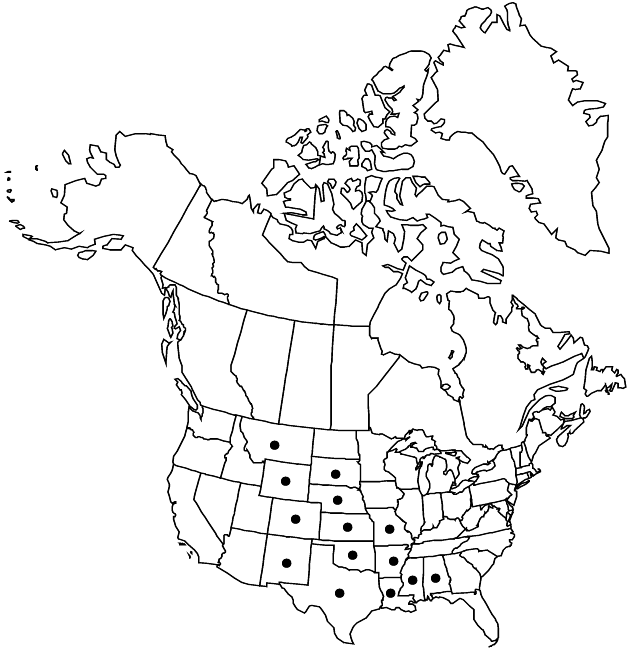Difference between revisions of "Diaperia prolifera"
Trans. Amer. Philos. Soc., n. s. 7: 338. 1840.
FNA>Volume Importer |
RevisionBot (talk | contribs) m (Bot: Adding category Revised Since Print) |
||
| (3 intermediate revisions by 2 users not shown) | |||
| Line 8: | Line 8: | ||
}} | }} | ||
|common_names=Big-head rabbit-tobacco | |common_names=Big-head rabbit-tobacco | ||
| + | |special_status={{Treatment/ID/Special_status | ||
| + | |code=F | ||
| + | |label=Illustrated | ||
| + | }}{{Treatment/ID/Special_status | ||
| + | |code=E | ||
| + | |label=Endemic | ||
| + | }} | ||
|basionyms={{Treatment/ID/Basionym | |basionyms={{Treatment/ID/Basionym | ||
|name=Evax prolifera | |name=Evax prolifera | ||
| Line 26: | Line 33: | ||
-->{{Treatment/Body | -->{{Treatment/Body | ||
| − | |distribution= | + | |distribution=Ala.;Ark.;Colo.;Kans.;La.;Miss.;Mo.;Mont.;N.Mex.;Nebr.;Okla.;S.Dak.;Tex.;Wyo. |
|discussion=<p>Varieties 2 (2 in the flora).</p><!-- | |discussion=<p>Varieties 2 (2 in the flora).</p><!-- | ||
--><p>Intermediates between the two varieties of <i>Diaperia prolifera</i> occur where their ranges meet in central Texas and central Oklahoma. The strictly dichasiform or pseudo-polytomous branching pattern of <i>D. prolifera</i> is distinctive and diagnostic within the genus. Specimens of <i>D. prolifera</i> from introductions around a wool mill in South Carolina (G. L. Nesom 2004c, as Evax prolifera) are as yet undetermined to variety and are not included in the distributions below.</p> | --><p>Intermediates between the two varieties of <i>Diaperia prolifera</i> occur where their ranges meet in central Texas and central Oklahoma. The strictly dichasiform or pseudo-polytomous branching pattern of <i>D. prolifera</i> is distinctive and diagnostic within the genus. Specimens of <i>D. prolifera</i> from introductions around a wool mill in South Carolina (G. L. Nesom 2004c, as Evax prolifera) are as yet undetermined to variety and are not included in the distributions below.</p> | ||
| Line 57: | Line 64: | ||
|basionyms=Evax prolifera | |basionyms=Evax prolifera | ||
|family=Asteraceae | |family=Asteraceae | ||
| − | |distribution= | + | |distribution=Ala.;Ark.;Colo.;Kans.;La.;Miss.;Mo.;Mont.;N.Mex.;Nebr.;Okla.;S.Dak.;Tex.;Wyo. |
|reference=None | |reference=None | ||
|publication title=Trans. Amer. Philos. Soc., n. s. | |publication title=Trans. Amer. Philos. Soc., n. s. | ||
|publication year=1840 | |publication year=1840 | ||
| − | |special status= | + | |special status=Illustrated;Endemic |
| − | |source xml=https:// | + | |source xml=https://bitbucket.org/aafc-mbb/fna-data-curation/src/2e0870ddd59836b60bcf96646a41e87ea5a5943a/coarse_grained_fna_xml/V19-20-21/V19_771.xml |
|tribe=Asteraceae tribe Gnaphalieae | |tribe=Asteraceae tribe Gnaphalieae | ||
|genus=Diaperia | |genus=Diaperia | ||
| Line 68: | Line 75: | ||
}}<!-- | }}<!-- | ||
| − | -->[[Category:Treatment]][[Category:Diaperia]] | + | --> |
| + | |||
| + | [[Category:Treatment]] | ||
| + | [[Category:Diaperia]] | ||
| + | [[Category:Revised Since Print]] | ||
Latest revision as of 18:19, 6 November 2020
Plants grayish green to silvery, 3–15 cm, sericeous to lanuginose. Stems mostly 2–10; branches proximal and distal (distal opposite or, sometimes, appearing alternate when unequal), rarely none. Leaves: largest 7–15 × 2–4 mm; capitular leaves subtending glomerules, also visible between and surpassing heads. Heads in strictly dichasiform or pseudo-polytomous arrays (sometimes appearing monochasiiform), cylindric to ± ellipsoid, 3.5–4.5 mm, heights 2–3 times diams. Receptacles broadly or narrowly conic, 0.4–0.6 mm or ± 0.9–1.1 mm, heights 0.5–0.7 or 2–2.4 times diams. Pistillate paleae imbricate, longest 2.5–4 mm. Staminate paleae ± 3, apices erect to somewhat spreading, ± plane. Functionally staminate florets 2–4; ovaries partly developed, 0.4–0.6 mm; corollas hidden in heads, actinomorphic, 1.4–2 mm, glabrous, lobes equal. Bisexual florets 0. Cypselae ± angular, obcompressed, mostly 0.9–1.2 mm.
Distribution

Ala., Ark., Colo., Kans., La., Miss., Mo., Mont., N.Mex., Nebr., Okla., S.Dak., Tex., Wyo.
Discussion
Varieties 2 (2 in the flora).
Intermediates between the two varieties of Diaperia prolifera occur where their ranges meet in central Texas and central Oklahoma. The strictly dichasiform or pseudo-polytomous branching pattern of D. prolifera is distinctive and diagnostic within the genus. Specimens of D. prolifera from introductions around a wool mill in South Carolina (G. L. Nesom 2004c, as Evax prolifera) are as yet undetermined to variety and are not included in the distributions below.
Selected References
None.
Key
| 1 | Plants grayish to greenish, loosely lanuginose; heads 4–40+ in largest glomerules; receptacle heights mostly 0.5–0.7 times diams.; capitular leaves usually ± spreading, scarcely involucral, not or scarcely carinate, pliant to somewhat rigid; distal branches mostly spreading to ascending; longest pistillate paleae 3.3–4 mm | Diaperia prolifera var. prolifera |
| 1 | Plants silvery white, tightly sericeous; heads borne singly, or 2–3 in largest glomerules; receptacle heights mostly 2–2.4 times diams.; capitular leaves erect, involucral, proximally carinate, becoming indurate; distal branches strictly ascending to erect; longest pistillate paleae 2.5–3.2 mm | Diaperia prolifera var. barnebyi |